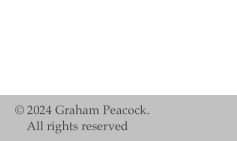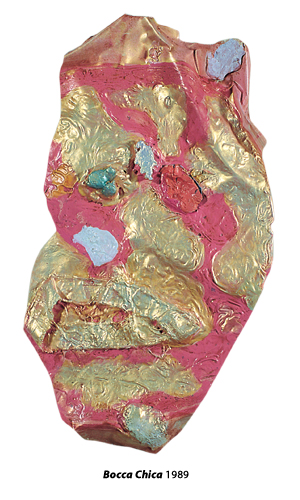|
The Rocaille Suite Paintings on Paper
1987-1989
(irregular shaped acrylic on rag paper)
Click here or on the painting to visit this Gallery
By 1988, I had begun to consider the possibility of letting the shape of the painting become less angular and more irregular. Making the outside shape generate itself by becoming the product of the internal drawing and colour in the paint formations. As Belgian Philosopher Marcel Paquet once wrote about my work "painting the painting from the inside out". To explore this notion I made a large group of works on paper, the 'Rocaille Suite'. The papers were so titled by the exclamation of Roger Boulet, then Director of The Edmonton Art Gallery, on seeing the styrene gel coated noodles in the pourings, he said they look like 'rocaille' the French word for formations resembling rock-like clusters. The 'Rocaille' paper works represent the transition and evolution from the flat geometric shaping of the 1980s into the irregular shaping and dimensional surfaces of the 1990s. In these works I have tried a large range of composition ideas and allowed the resultant shaping of the poured formations on what became a distorted rectangle of paper tensioned by the drying of the paint. I placed sheets of paper in troughs (frames with raised edges to contain the paint), and in some I used blocks on the underside to create an embossing effect on the dried surface. These internal undulations of the paper helped balance the resultant undulation of the edges of the paper. I made full sheet, half sheet, quarter sheet, and some miniatures works in this way.
The drawing and imagery in these works shows an exploration between distinct configuration, associative imagery, and all-over crazed formations which can be seen in my earlier paintings. The range of formation and colour have many inherent associations with forms in nature. I rely on these as the compositional and pictorial content of my work. Rock formations, tidal pools, and many close up details and macro examinations of the earth and the human body, cell structures, are closely related to my 'subject matter' or matter itself. I use paint in a metaphysical way and create a fluid pond of colour of various viscosities. I introuduce collage elements, pieces of paper,painted canvas, acrylic castings, paint skins, etc, and control the time of the introduction of collage, and the rate of drying of the 'pond' to exploit the behavior the nature of paint itself.
In the first group of papers there was less undulation of the surface and the edges were left mostly unpainted. As the edges of the poured shapes became more assertive I painted the edges/border with a brushed colour to compliment the poured colours. In a small group of these papers I went so far as to remove the border altogether and cut out the shape. This was a significant indication of how my paintings were to develop in the next few years. Agnes Bugera at the Gallery on Whyte showed the first group of papers in 1988.
These paper works are mounted on acid free rag card to retain their undulation and then on a foam core backing and placed under glass in a deep metal gold frame. Placing these papers under glass is a suitable way of presenting them, but viewing the works unglazed was for me always preferable. The later group of 'Rocaille Suite' paper pieces were also mounted on acid free card and attached to a conventional stretched canvas support, framed with stained clear pinewood, finished with gold edge stripping. These canvases leave a background which is coloured to suit the painting. All the paper have several coats of varnish to protect them. Not being glazed these later works are light and readily transportable suitable for smaller traveling exhibitions. Framing and presentation of these works is essentially optional but the framing should ideally be neutral and suited to the environment in which the work is displayed. This is the same notion that has prevailed for centuries where the frame would always be an architectural feature and be in character with the rooms’ period and décor.
I use the nature of the process and materials for my epression of life, searching for the uplifting sensations I orchestrate by my command and knowlege of the perceptual language and my hypothesise and exploration of what might be discouvered, always looking and responding to what is taking place as I work. Whie I have established preccedents for my way of working I am always open and adjusting as I work to what sensations trigger my interest. Just as a painter does when paint flows of a brush onto the canavas. The Brush School. But instead of brushes, I pour, using a fluid process as in the work of Juan Miro, Jackson Pollock, Helen Frankenthaler , Morris Louis and the Cascade works of Laurence Poons. A group of modern artist I refer to as the Fluid School.
I believe that many new way of painting will evolve from new and present processes of modyfying the paint medium if artists gain the same knowledge as has been the case with oil painting over the centuries. Propriety restrictions and acess to basic materials is presently restrictive to this kind of investigation and a knowlege of basic chemistry is fundamental to such an inquiry, due to the inherent danger of some of the materials.
|
|
|





